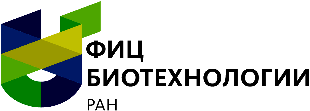The Shared-Access Equipment Centre “Industrial Biotechnology” of A.N. Bach Institute of biochemistry RAS provides the following services (contract for rendering service).
For viewing the data about services please choose one the department.
Typical services:
1. Chromatographic analysis (without sample preparation and results discussion, using standard protocol).
2. CE analysis (without sample preparation and results discussion, using standard protocol).
3. XRF analysis (without sample preparation and results discussion, using standard protocol).Non-typical services:
1. Chromatographic analysis (including sample preparation and results discussion, method development).
2. CE analysis (including sample preparation and results discussion, method development).
3. XRF analysis (including sample preparation and results discussion, method development).Typical services:
1. Getting mass spectra of the protein after proteolysis by trypsin in reflectron mode in the mass range 500-6500Da (without prior proteolysis and processing of the spectrum)Non-typical services:
1. Protein identification in gel or in the desalted solution by “peptide fingerprint” (Trypsinolysis of protein in the gel or solution, getting mass spectra using MALDI, proteinsearch in databases using Mascot)
2. Getting one fragmentation spectrum (ms/ms) of individual peptides after a preliminary identification of the protein
3. Getting molecular weight of sampleTypical services:
1. Measurement of the spectrum of CD (proteins, nucleic acids, etc.) in the field 176-350 nm with a step of 1 nm, spectral slit width 1 nm and a time constant of 3 sec at a fixing temperature (5 to 80 °C)
2. Measurement of the spectrum of CD (pigments, dyes, etc.) in the range of 300 – 825 nm with a step of 1 nm, spectral slit width 1 nm and a time constant of 3 sec at a fixed temperature (5 to 80 °C)
3.Measurement of the melting curve (from 5 to 90 0C) and the amplitude of the signal CD and absorption at one wavelength and the rate of heating 1°/min.
4. The fluorescence spectrum measurement at room temperature (300 -830 nm)
5.The fluorescence spectrum measurement at the temperature of liquid nitrogen (400-830 nm)
6. Measurement of the absorption spectrum of solutions and films at a fixed temperature (10-80) in the region of 190 -1100 nm
Note: after the measurements are transmitted to a SCV file format, TXTNon-typical services:
1. Determination of extinction coefficient of proteins
2.Determination of protein secondary structure by CD spectrum (program Dichroweb and more)
3.Determination of quantum yields of fluorescence
4. Computer processing of measured spectrum (averaging, smoothing, additional correction base lines, etc.) Making drawings (with captions date, sample, measurement conditions, etc.)
5. Comparative analysis of spectra of multiple samples, the formation of the consolidated figures, tables, formulation of findings, conclusions, and recommendations
6.Analysis of a multicomponent mixture in the spectra of CD, absorption, and fluorescence (selective fluorescence excitation, the spectra differentiation, Gaussian decomposition, the decomposition own vectors)
7. Determination of the effectiveness of the migration energy of a multicomponent mixture of the fluorescent molecules
Note: after measurement files are transferred in format, Origin, and/or text with images in Word formatTypical services:
1. Synthesis and isolation of a conjugate between gold nanoparticle and a protein (without preliminary purification of this protein, without matching the protein concentration, without characterization of the conjugate)Non-typical services:
1. Synthesis and characterization of a conjugate between gold nanoparticle and a protein (with preliminary purification of this protein, with matching optimal concentration of the protein, with characterization of the conjugate)
2. Synthesis of a row of conjugates between gold nanoparticles and proteins differing in composition, size of the nanoparticles, and mode of immobilization.
3. Testing conjugates between gold nanoparticles and proteins for their functional activity (stored ability to receptor-ligand interactions for immobilized protein) by enzyme immunoassay and immunochromatography.Typical services:
1. Fermentation in batch culture on a standard protocol
2. Fermentation in feed-batch culture on a standard protocol
3. Creation of the expression cassette and construction of a protein strain-producer in the E. coli.
4. Creation of the expression cassette and construction of a protein strain-producer in the yeast (Saccharomyces cerevisiae or Pichia pastoris)Non-typical services:
1. Optimization of culture medium and fermentation conditions of the batch fermentation for maximal protein production
2. Optimization of culture medium and fermentation conditions of the in feed – batch fermentation for maximal protein production
3. Creation and optimization of the expression cassette, selection of recombinant protein strain-producer and chaperones status improvement with folding optimization
4. Real-time PCR with sample preparation and processing of results
5.Fermentation at the optimal conditions on the available equipment
6. Construction of the recombinant protein strain-producer in the E. coli, the yeast Saccharomyces cerevisiae or Pichia pastoris on the available equipmentTypical services:
1. Cultivation of microorganisms according to the parameters agreed with the customer (the nutrient medium and microorganisms are provided by the customer).Non-typical services:
1. Cultivation of microorganisms, which includes the sterilization of growth media and getting the finished product.
